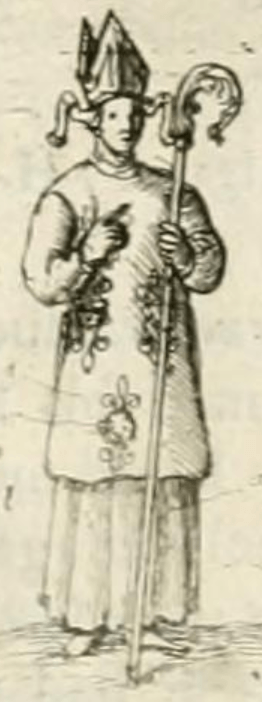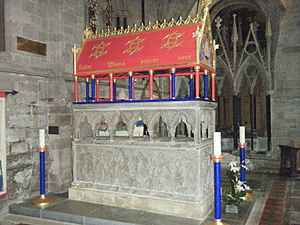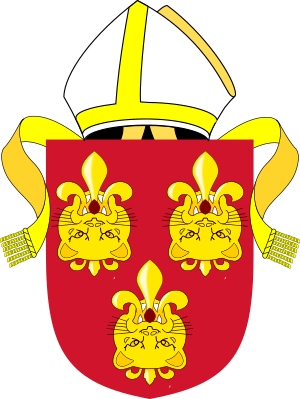Thomas de Cantilupe facts for kids
Quick facts for kids Thomas de Cantilupe |
|
|---|---|
| Bishop of Hereford | |

Thomas de Cantilupe depicted in a now lost stained glass window in the Church of St James the Great, Snitterfield, Warwickshire, a manor held by the Cantilupe family until 1323; 1656 drawing by William Dugdale. On his tunic he displays his differenced arms of Cantilupe – gules, three fleur-de-lis issuant from a leopard's head or. Later, on his canonization, the see of Hereford adopted yet would further difference his arms, inverting the leopard's head.
|
|
| Enthroned | 1275 |
| Reign ended | 1282 |
| Predecessor | John de Breton |
| Successor | Richard Swinefield |
| Orders | |
| Consecration | 8 September 1275 by Archbishop Robert Kilwardby, O.P., with co-consecrators Bishop John Chishull and Bishop Walter de Merton |
| Personal details | |
| Born | c. 1218 Hambleden, Buckinghamshire, England |
| Died | 25 August 1282 (aged 63–64) Ferento, Montefiascone, Papal States (now Italy) |
| Denomination | Catholic |
| Sainthood | |
| Feast day | 25 August 2 October |
| Venerated in | Roman Catholic Church; Anglican Communion |
| Title as Saint | Thomas of Hereford |
| Canonized | 17 April 1320 by Pope John XXII |
| Attributes | dressed as a bishop |
| Shrines | Hereford Cathedral |
Thomas de Cantilupe (born around 1218, died August 25, 1282) was an important person in English history. He served as the Lord Chancellor of England and later became the Bishop of Hereford. In 1320, he was officially recognized as a saint by Pope John XXII.
Contents
Early Life and Family
Thomas was the third son of William II de Cantilupe. His father was a steward, a kind of manager, for King Henry III. Thomas's grandfather, William I de Cantilupe, had also been a steward for King John.
Thomas's mother was Millicent de Gournai. She was the widow of a French nobleman. Thomas was born in Hambleden, Buckinghamshire, England. His uncle, Walter de Cantilupe, was also a bishop, serving in Worcester.
Education and Early Career
Thomas studied at famous universities like Oxford, Paris, and Orléans. He became a teacher of canon law, which is the law of the church. In 1261, he became the Chancellor (head) of Oxford University.
During a time of civil war in England, called the Second Barons' War, Thomas supported Simon de Montfort and the group of powerful noblemen. He even spoke for them to the King of France in 1264.
In February 1264, Thomas became the Lord Chancellor of England. This was a very important job, like a chief minister to the king. However, he lost this job after Simon de Montfort died in battle. Thomas then lived outside England for a short time. When he returned, he again became Chancellor of Oxford University. He also taught theology and held several church positions.
Becoming Bishop of Hereford
In 1274, Thomas attended an important church meeting in France. On June 14, 1275, he was chosen to be the Bishop of Hereford. He officially became bishop on September 8, 1275.
As bishop, Thomas became a trusted advisor to King Edward I. Even when he disagreed with the king, he still kept the king's favor.
Thomas had a big disagreement with a powerful nobleman, Gilbert de Clare, in 1290. This argument was about hunting rights and some land. The problem was solved through a costly legal process.
After his friend and confessor, Archbishop Robert Kilwardby, died in 1279, Thomas had several arguments with the new archbishop, John Peckham. These disagreements became so serious that Archbishop Peckham removed Thomas from the church (excommunicated him). Thomas then traveled to Rome to discuss the matter with the Pope.
Death and Becoming a Saint

Thomas de Cantilupe died in Italy on August 25, 1282. He was buried in Hereford Cathedral in England.
One of the stories used to support him becoming a saint was about a Welsh rebel named William Cragh. It was said that William Cragh was brought back to life after being hanged, eight years after Thomas's death.
A church investigation began in 1307 to decide if Thomas could be made a saint. They needed to make sure he had not died excommunicated. After many witnesses and letters, the investigators decided that Thomas had been forgiven by the Pope before he died.
After a long investigation, Thomas de Cantilupe was officially made a saint by Pope John XXII on April 17, 1320. His special day of celebration is October 2. His shrine (a special place where he is honored) in Hereford Cathedral became a popular place for people to visit.
Legacy and Impact
Thomas de Cantilupe was known as an excellent bishop. He was very generous to the poor and lived a good life. He often visited his diocese (the area he was responsible for) to help people and make sure things were running well. He also made sure that land that belonged to the church was returned.
Some people have even called Thomas the "Father of Modern Charity." He is seen as an inspiration by famous figures like Mother Teresa.
A group called the Cantilupe Society was started in 1905. Their goal was to publish old records from the Hereford Cathedral and diocese. Thomas's records are the earliest ones that still exist.
Thomas de Cantilupe is mentioned in a book called Travels With My Aunt. In the book, a character says he was lucky to die in Italy, which she describes as a "civilized place" with a "far, far better climate" than Hereford.



